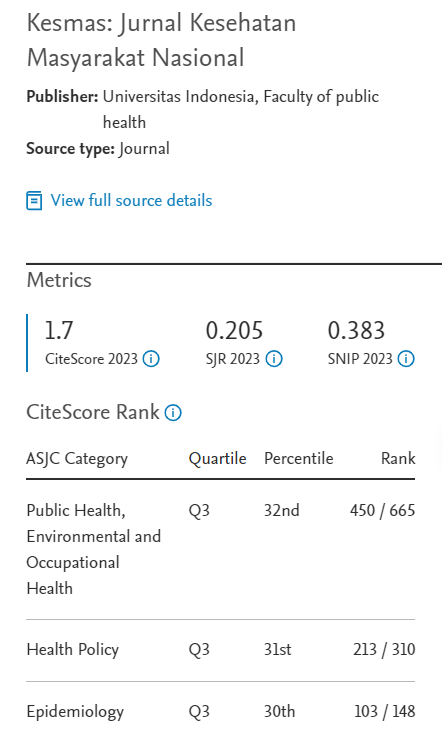Abstract
Abortus menjadi masalah yang penting dalam kesehatan masyarakat karena berpengaruh terhadap morbiditas dan mortalitas maternal. Di Indonesia, belum ada data yang komprehensif tentang kejadian abortus, berbagai data yang ada sebelumnya berdasarkan survei dengan cakupan yang relatif terbatas. Abortus yang tidak aman bertanggung jawab terhadap 11% kematian ibu di Indonesia. Penelitian ini bertujuan untuk mengetahui faktor-faktor yang berhubungan dengan kejadian abortus di Indonesia. Penelitian ini dilaksanakan dengan metode observasional menggunakan disain studi cross sectional. Data penelitian diperoleh dari data Survei Demografi dan Kesehatan Indonesia 2002-2003. Analisis data dilakukan secara bertahap yaitu: analisis univariat, analisis bivariat dan analisis multivariat dengan regresi logistik. Hasil menunjukkan bahwa risiko abortus meningkat seiring dengan peningkatan usia ibu. Wanita dengan paritas 0-2 berisiko lebih tinggi untuk mengalami abortus dibandingkan wanita dengan paritas 3 atau lebih (OR=5,2, IK 95%=3,49-7,89). Wanita yang bekerja berisiko 2,7 kali lebih tinggi untuk mengalami aborsi daripada wanita yang tidak bekerja (OR= 2,7 , IK 95%= 2,10-3,58). Selain itu, risiko abortus meningkat pada wanita yang menikah pada usia 30 tahun atau lebih (OR=1,8, IK95%= 1,30-2,48). Risiko abortus tidak berhubungan bermakna dengan riwayat abortus sebelumnya, tingkat pendidikan dan tingkat sosial ekonomi.
Abortion has become a main problem in public health because of its impact on maternal morbidity and mortality. There is no comprehensive data on abortion in Indonesia. So far, data were based on survey with limited coverage. Unsafe abortion is responsible to 11 percent of maternal mortality in Indonesia. This research objective is to determine factors related to abortion in Indonesia. The study was an observational method with cross sectional design. These data are gathered from Indonesian Demography and Health Survey 2002–2003. Data analysis used univariate, bivariate and multivariate analysis with logistic regression. The risk of an abortion increased in line with the increasing of maternal age. Women with 0-2 parity have higher risk than multiparity (OR=5.2, IK95%=3.49-7.89). Employed women have higher risk than unemployed (OR=2.7, IK95%=2.10-3.58). The risk of abortion increased among women married at 30 years old or over (OR=1.8, IK95%=1.30-2.48). There is no significant association between history of abortion, education, socioeconomic and risk of abortion.
References
- Nojomi M, Akbarian A, Ashory-Moghadam S. Burden of abortion: induced and spontaneous. Arch Iranian Med. 2006; 9: 39-45.
- Nybo-Anderson AM, Wohlfahrt J, Christens P, Olsen J, Melbye M. Maternal age and fetal loss: population-based register linkage study.
- Slama R, Werwatz A, Boutou O, Ducot B, Spira A, Hardle W. Does male age affect the risk of spontaneous abortion? an approach using semimetric regression. Am J Epidemiol. 2003; 157: 815-24.
- Henshaw SK, Singh S, Haas T. The incidence of abortion worldwide. Int Fam Plan Perspect. 1999; 25: S30-S38.
- Ba-Thike K. Abortion: a public health problem in Myanmar. Reprod Health Matters. 1997; 9: 94-100.
- World Health Organization. Unsafe abortion: global and regional estimates of incidence of and mortality due to unsafe abortion with a listing of available country data. Third Edition. Geneva: Division of Reproductive Health (Technical Support) WHO; 1998. WHO/RHT/MSM/97.16-1997.
- Wilopo SA. Makalah kunci. Seminar kita selamatkan remaja dari abortus dalam rangka pemantapan keluarga berkualitas 2015. Medan, 11 April 2005.
- BPS, BKKBN, Depkes, DHS. Survei demografi dan kesehatan 2002- 2003. Calverton, Maryland: Biro Pusat Statistik, Badan Koordinasi Keluarga Berencana, Departemen Kesehatan, dan Macro International; 2003.
- De La Rochebrochard E, Mcelreavey K, Thonneau P. Paternal age over 40 Years: The “amber light” in the reproductive life of men? J Androl. 2003; 24: 459-65. 1
- De La Rochebrochard E, Thonneau P. Paternal age and maternal age are risk factors for miscarriage; results of multicentre European study. Hum Reprod. 2002; 17: 1649-56.
- Nybo Andersen AM, Hansen KD, Andersen PK, Smith GD. Advanced paternal age and risk of fetal death: a cohort study. Am J Epidemiol. 2004; 160: 1214-22.
- Ness RB, Grisso JA, Hirschinger N, Markovic N, ShawLM, Day NL, Kline J. Cocaine and tobacco and the risk of spontaneous abortion. N Engl J Med. 1999; 340: 333-9.
- Tolstrup JS, Kjaer SK, Munk C, Madsen LB, Ottesen B, Bergholt T, et al. Does caffeine and alcohol intake before pregnancy predict the occurence of spontaneous abortion? Hum Reprod. 2003;18: 2704-10.
- Kesmodel U, Wisborg K, Olsen SF, Henriksen TB, Secher NJ. Moderate alcohol intake in pregnancy and the risk of spontaneous abortion. Alcohol Alcohol. 2002; 37: 87-92.
- Sun Y, Che Y, Gao E, Olsen J, Zhou W. Induced abortion and risk of subsequent miscarriage. Int J Epidemiol. 2003; 32: 449-54.
- Llewellyn-Jones D. Fundamentals of obstetrics and gynaecology. Edisi ke-6. Edisi Bahasa Indonesia. Jakarta: Hipokrates; 2001.
- Heffner LJ. Advanced maternal age- how old is too old? N Engl J Med. 2004; 351; 19: 1927-29.
- Yassin KM. Incidence and socioeconomic determinants of abortion in rural upper Egypt. Public Health. 2000; 114: 269-72.
- Melki IS, Beydoun HA, Khogali M, Tamim H, Yunis KA. Household crowding index: a correlate of socioeconomic status and inter-pregnancy spacing in an urban setting. J Epidemiol Community Health. 2003; 58: 476-80.
Recommended Citation
Kuntari T , Wilopo SA , Emilia O ,
et al.
Determinan Abortus di Indonesia.
Kesmas.
2010;
4(5):
223-229
DOI: 10.21109/kesmas.v4i5.173
Available at:
https://scholarhub.ui.ac.id/kesmas/vol4/iss5/5







